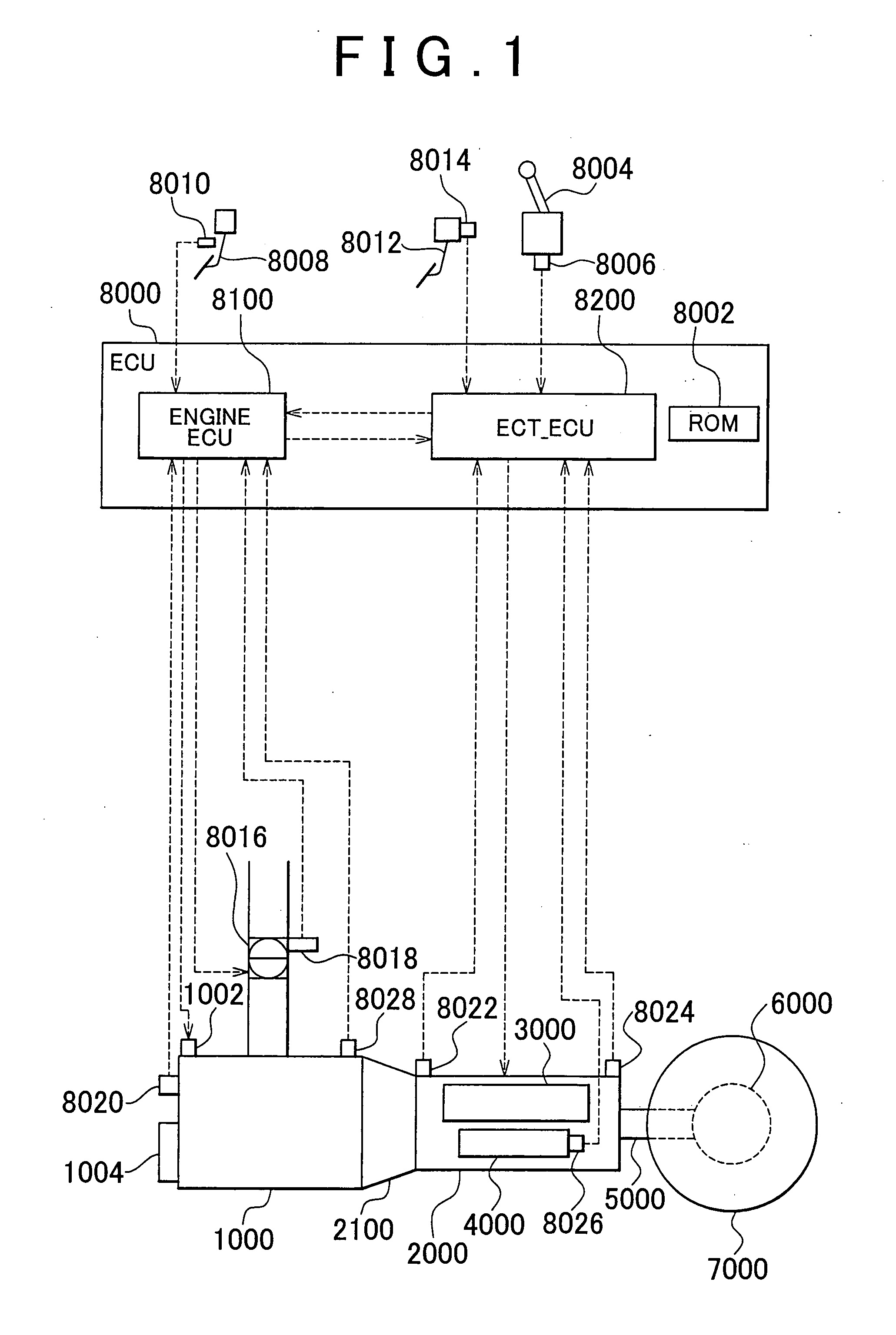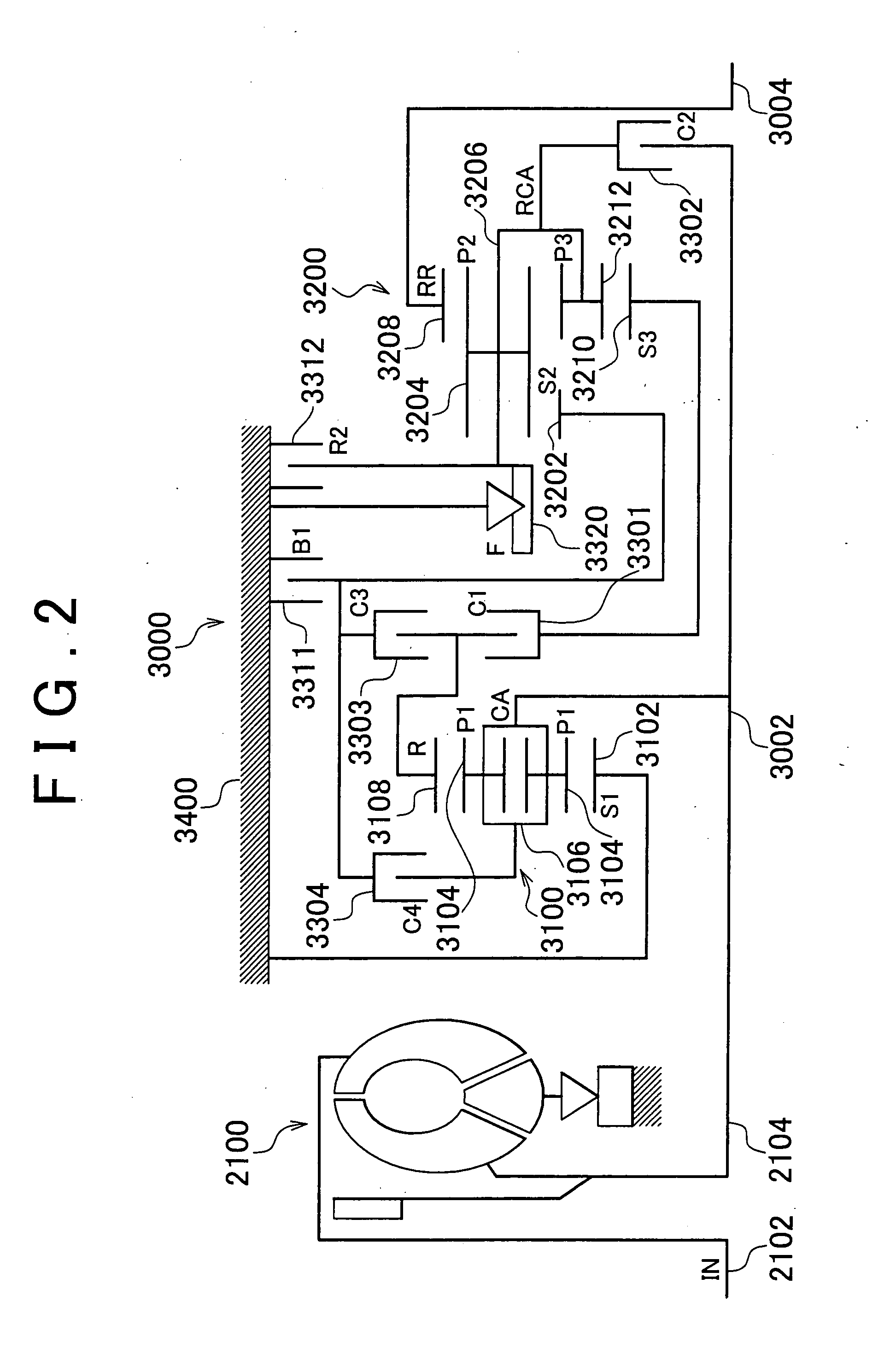[0010]An object of the present invention is to provide an apparatus for and a method of controlling a power
train that reduce the shock that can occur in the course of a shift, and a storage medium storing a program for implementing the method.
[0012]According to the first or fifth aspect, an
inertia phase is started at the time of the downshift by gradually reducing the torque capacity of the frictional engagement device that is brought from an engaged state into a disengaged state. When at least one of the rate of change in the rotation speed of the rotary member (the input shaft, for example) of the automatic transmission, and the rate of change in the speed ratio of the automatic transmission has reached a predetermined value, the gradual reduction of the torque capacity of the frictional engagement device is stopped. Thus, it is possible to prevent the torque capacity of the frictional engagement device from being unnecessarily reduced. Accordingly, it is possible to keep small the variation in the output torque from the automatic transmission during transition from an inertia phase to a torque phase by preventing the torque transmitted to the output shaft from being reduced during the inertia phase. Thus, it is possible to provide an apparatus for and a method of controlling a power train that reduce the shock that can occur at the time of a shift.
[0014]According to this aspect, after the gradual reduction of the torque capacity of the frictional engagement device is stopped, the torque capacity of the frictional engagement device is controlled according to input torque supplied to the automatic transmission, and the torque capacity of the frictional engagement device is controlled so that at least one of the rate of change in the rotation speed of the rotary member of the automatic transmission, and the rate of change in the speed ratio of the automatic transmission is maintained at the predetermined value. Thus, it is possible to prevent excess and deficiency of the torque capacity of the frictional engagement device in relation to the input torque supplied to the automatic transmission. In addition, it is possible to prevent the torque capacity of the frictional engagement device from being unnecessarily reduced. Thus, it is possible to keep small the variation in the output torque from the automatic transmission during transition from an inertia phase to a torque phase by preventing the torque transmitted to the output shaft from being reduced in the inertia phase. As a result, it becomes possible to reduce the shock that can occur at the time of a shift.
[0016]With these aspects, the power train is controlled so that rotation speed of an input shaft of the automatic transmission becomes higher than a synchronized rotation speed with respect to the lower gear within a predetermined range in an inertia phase of the downshift. In addition, control is performed so that torque capacity of the first frictional engagement device that is brought from an engaged state into a disengaged state at the time of the downshift is gradually reduced, and that torque capacity of the second frictional engagement device that is brought from a disengaged state into an engaged state is gradually increased when the rotation speed of the input shaft of the automatic transmission becomes higher than the synchronized rotation speed with respect to the lower gear within the predetermined range in the inertia phase of the downshift. Thus, it is possible to start the gradual reduction of the torque capacity of the first frictional engagement device and the
gradual increase of the torque capacity of the second frictional engagement device under conditions in which the rotation speed of the input shaft of the automatic transmission is higher than the synchronized rotation speed with respect to the lower gear, and thus to reduce the rotation speed of the input shaft to the synchronized rotation speed. Reduction of the rotation speed of the input shaft to the synchronized rotation speed is controlled more easily than increase of the rotation speed of the input shaft to the synchronized rotation speed. Thus, it is possible to keep small the variation in the output torque from the automatic transmission during a shift by smoothly reducing the rotation speed of the input shaft to the synchronized rotation speed. Moreover, control is performed so that reduction of the amount of boost of the output torque from the driving power source is started after the rotation speed of the input shaft is reduced to the synchronized rotation speed. As a result, during the period from when gradual reduction of the torque capacity of the first frictional engagement device and
gradual increase of the torque capacity of the second frictional engagement device are started to when rotation speed of the input shaft is reduced to the synchronized rotation speed, that is, at the final stage of the inertia phase, the output torque from the engine is not varied, and only the torque capacities of the two frictional engagement devices are varied. Varying only the torque capacities of two frictional engagement devices is controlled more easily than varying the output torque from the driving power source in addition to the torque capacities of two frictional engagement devices. Thus, it is possible to keep variation in the output torque from the automatic transmission small. Thus, it is possible to provide an apparatus for and a method of controlling a power train that reduce the shock that can occur at the time of a shift.
[0018]According to the third or seventh aspect, in the inertia phase, the torque capacity of the first frictional engagement device is gradually reduced, and the torque capacity of the second frictional engagement device is gradually increased, while maintaining a relation between the torque capacities such that the output torque from the automatic transmission at the end of the inertia phase and the output torque therefrom at the start of the subsequent torque phase are equalized to each other. In this way, the curves of the output torque from the automatic transmission are smoothly connected at the point of the transition from an inertia phase to a torque phase. Thus, it is possible to keep small the variation in the output torque from the automatic transmission during transition from an inertia phase to a torque phase. As a result, it becomes possible to provide an apparatus for and a method of controlling a power train that reduce the shock that can occur at the time of a shift.
[0020]According to the fourth or eighth aspect, reduction of the amount of boost of the output torque from the driving power source and reduction of torque capacity of the frictional engagement device in a torque phase of the downshift are synchronously started. Similarly, the reduction of the amount of boost of the output torque from the driving power source and the reduction of the torque capacity of the frictional engagement device in the torque phase of the downshift are synchronously completed. Thus, it is possible to prevent the torque capacity of the frictional engagement device from becoming excessive or insufficient in relation to the output torque from the driving power source, that is, the input torque supplied to the automatic transmission during the torque phase. Thus, it is possible to keep variation in the output torque from the automatic transmission small. As a result, it becomes possible to provide an apparatus for and a method of controlling a power train that reduce the shock that can occur at the time of a shift.
 Login to View More
Login to View More  Login to View More
Login to View More 


